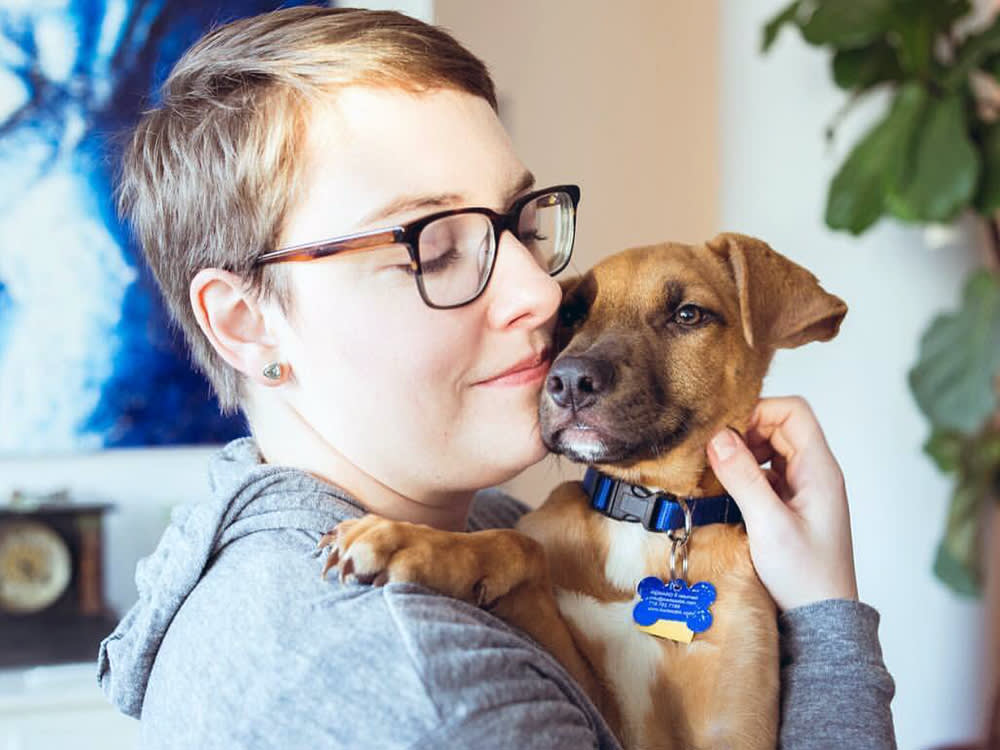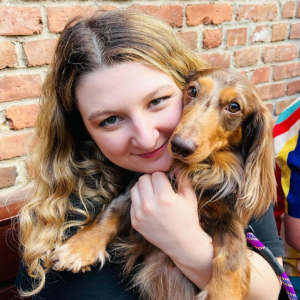At Badass Rescue, You Can Get a Private Concert From Joni Mitchell
In barks. She’s a dog. Was that not clear?

Share Article
Before 2013, Badass Rescueopens in new tab’s executive director, Krista Almqvist, was a nanny for child actors, which is not unlike wrangling high-energy pups but is definitely, well, not the same thing.
At the time, Almqvist’s involvement with animal rescue was limited: She and her husband wanted to adopt a dog, so they went to Badass, a Brooklyn-based rescue organization that focuses on saving pups from high-kill shelters (and gives them all temporary celebrity namesopens in new tab). Three months later, she was a volunteer at the rescue. Now, nine years and two dogs later, Almqvist is Badass’s first-ever executive director, tasked with leading this tight-knit community of fosters and volunteers.

Save on the litter with color-changing tech that helps you better care for your cat.
The timing couldn’t be more bittersweet, with overwhelming returns and surrenders from the aftermath of the pandemic pet boom running rampant, most rescues are in a state of crisis.
Thanks to Badass’s model of rescue sustainability, though, the organization has been able to keep its head above water and its dogs in loving homes. For more on this impressive feat, Kinship sat down with Almqvist to talk about how Badass stays ahead of the pack.
Tell us a little bit about yourself and how you started working with Badass Rescue.
I adopted my first Badass pup in 2013. My husband and I had been looking for a dog. He was a 6-month-old hound puppy from Alabama. We adopted him in June 2013, and by September I was volunteering with Badass. I just dove right in. I started off doing their merch at events and then started fostering, adopted a second dog, and just kind of joined the foster team. From there, I became the rescue program assistant and then the director of rescue and now I'm the first executive director.
It’s funny; I was actually a nanny for child actors for many years in my adult life, so I spent a lot of time with kids and was just always out exploring stuff. But I’ve always been a lifelong animal lover; I grew up with a lot of different animals and also studied literature, which has nothing to do with nannying or dogs. So, it has been a very unconventional pathway to rescue.
What makes Badass stand out from other rescues?
Badass was founded in 2011 with a couple of main key points that were important then and just as important now. First is selecting the shelters, areas, and dogs that are in the greatest need. So, that means we pull from high-kill shelters in the rural South. Before we get involved many of these shelters have over 90 percent euthanasia rates. This means nine out of 10 Dogs never make it out alive. We get involved, we start working with other local animal welfare organizations and that means we can bring that number down significantly. The second is that we are truly an all-breed rescue.
We pull all breeds, all ages, all sizes, and we don't discriminate. We also take a lot of medical cases. So you know, heartworm dogs, dogs that have been shot, dogs with dangling legs, the types of things that a lot of organizations might not have the resources to take on, and we dive in headfirst with those. The last thing that was super important when we were founded and continues to be important now, is the community that we've built. When you rescue a dog or when you adopt a dog from Badass, you have an entire community behind you. And we are definitely one of the leaders in that concept of animal rescue. We have built a very open and welcoming community of volunteers and foster families that all work together really well. Whether you foster, adopt, or volunteer, you’re part of the Badass community.
The pandemic has led to a boom in pet ownership, how has that changed things around Badass?
Beginning in 2020 and 2021, we saw a huge increase in adoption applications and foster applications. We went from 150 applications a month to over 500. So we saw a boom, but we chose to focus on sustainability and being a responsible rescue. So that means that we did not go from 250 adoptions to 600 adoptions. And the reason for that is because of what's happening now, rescues are seeing a lot of returns across the board. Because, since opening back up, the interest in fostering and adopting has dramatically slowed. And a lot of shelters and a lot of rescues are seeing huge increases in owner surrenders and returns.
But we are not.
Our return rate has remained the same low percentage as it was pre-pandemic. The pandemic changed a lot for rescues for a couple of years, and now it’s changing again. Now I would say rescue across the nation is actually in more of a crisis now than it was during the entire pandemic.
Because of the high rate of return other rescues are seeing right now, what’s one thing you want prospective dog parents to know before rescuing?
Every adopter will have an idea of what the dog will look like or the size that they’re thinking about — but really the most important thing is thinking about energy level and temperament. When you bring a dog into your home, think about how that dog is going to fit into your life. So don’t go for the dog that you just think is really cute, because it might [not] be the right fit.
Instead, really take your time to find a dog that can be the right fit for your home and your lifestyle and make sure that you’re ready for a commitment. It takes up to three months for that initial decompression to happen. Dogs come to you, and they only know what they have been taught. So most of the time these rescues come to you not knowing a lot. Just be ready for a lot of patience and to put some work into it. And know that it's so worth it if you do.
What’s your favorite thing about rescuing?
There’s so many things I love about rescuing; it’s what I do with my entire life. However, I'll say some of the most rewarding things and what keeps me going with rescue is, you know, we pull a lot of dogs that come from areas where they’ve never seen a lot of people or cars. Some are very shy and shut down.
And it’s just the process of watching a dog that you meet in the shelter, who is very scared and hiding in the back of the kennel, who might take hours or sometimes days [to] come out or open up to you and watching the process from that first experience in the shelter to when they come up transport in New York.
And they remember you, but maybe they're still a little shy but then they enter foster and you watch them develop and open up and learn to trust and become dogs. That, to me, is the most rewarding thing about doing rescue, and especially because at Badass we don’t overlook the dogs that take a little bit longer.

Rebecca Caplan
Rebecca Caplan is a writer based in Brooklyn whose work has been featured in The New Yorker, Reductress, and Vulture. She lives in Brooklyn with her perfect, toothless dog Moose.